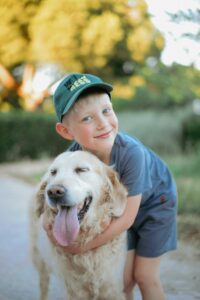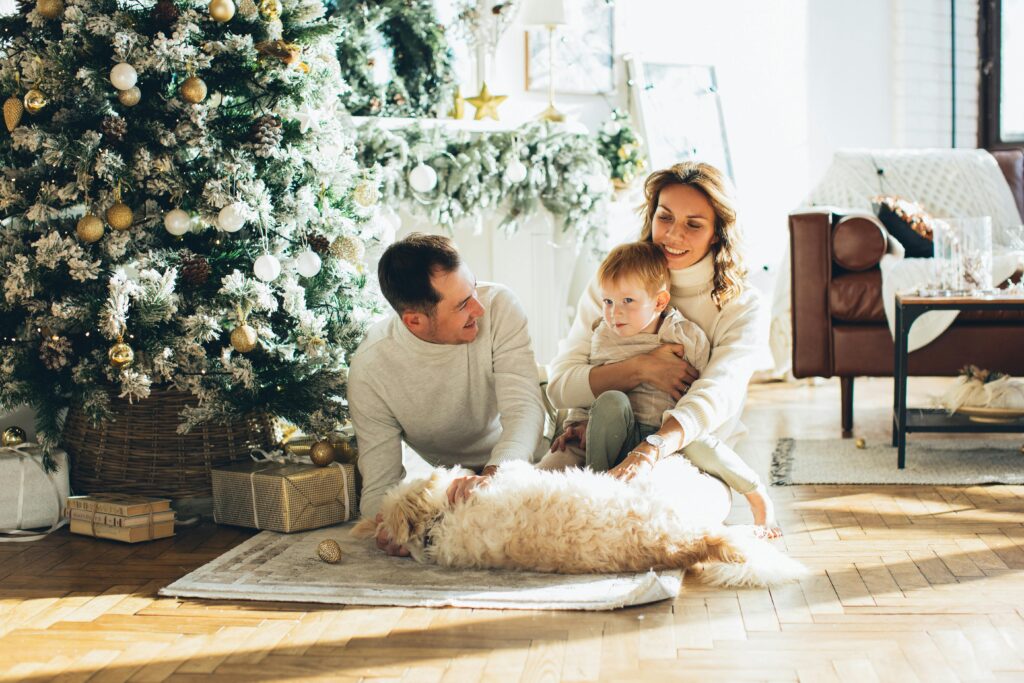Raising a dog in a household with children can be one of the most rewarding experiences. It can also be one of the most chaotic if you don’t have structure and clear boundaries in place. Kids bring high energy, unpredictability, and plenty of distractions, which means your dog needs to be well-prepared and conditioned for daily life in a busy home.
As a professional dog trainer, I’ve helped countless Chicago families build better routines, manage behavior challenges, and create safer, more peaceful homes. In this blog, I’ll share real-world tips and insights to help your dog thrive in a family environment.

Why Training Matters More in a Family Setting
Unlike a single-person household, family homes often come with:
- Multiple people giving commands (not always consistently)
- Fast movements and loud noise
- Toys, snacks, and unpredictable boundaries
- Emotional highs and lows that affect the dog’s environment
This kind of stimulation can confuse or overwhelm a dog, especially if they haven’t been taught how to navigate it calmly. That’s why structure, boundaries, and consistency are the backbone of training in homes with kids.
If you’re wondering how consistency plays a role in all of this, check out our blog on why consistency is the secret ingredient in dog training. You’ll quickly see how it applies to both adults and kids in your household.
Set Clear Household Rules for Everyone
One of the most common mistakes I see is parents training the dog while letting kids do whatever they want around the dog. That creates mixed messages and undermines your training.
Establish ground rules like:
- No disturbing the dog while sleeping or eating
- Always ask before petting
- No yelling, chasing, or climbing on the dog
- Use the same command words as parents
Kids don’t have to be left out of training. In fact, they can be a huge asset when included properly. But like your dog, they need clear expectations too.
Teach the “Place” Command Early
A solid “place” command can change the game in family households. Whether your toddler is throwing toys or the doorbell is ringing nonstop, having your dog go to a designated space helps reduce chaos and anxiety for everyone.
When trained properly, “place” teaches impulse control, respect for boundaries, and gives your dog an “off switch” during overstimulating situations.
Want a full breakdown on how to train this skill? Consider our Basic & Advanced Obedience Program to learn how to build and reinforce commands in real-life situations.
Make Training a Family Activity
Dogs thrive on clear communication and repetition, and there’s no better way to reinforce training than involving the whole family.
Try these fun activities:
- Command relay: One person gives a command, and another rewards.
- Obstacle course: Use furniture or cones for basic agility practice.
- Daily check-ins: Let kids take turns practicing “sit,” “down,” or “place” for 5 minutes per day.
These short sessions not only improve obedience but also deepen the bond between your dog and your children.
Use Positive Reinforcement, But Set Boundaries
It’s important to encourage both your dog and your kids with praise and rewards when they do something right. But rewards alone aren’t enough.
Dogs still need fair and timely corrections when rules are broken. Teaching your dog what not to do is just as critical as showing them what to do. Many families mistakenly avoid corrections and end up reinforcing problem behaviors. Structure brings clarity, not punishment.
Never Skip Supervision
Even the most well-trained dog shouldn’t be left alone with young children. Always supervise interactions, especially during:
- Mealtimes
- Rough play
- Naps or quiet time
- New social situations
Dogs are still animals. Even the most tolerant pup has limits. Teaching your kids to respect those boundaries is key to long-term safety.
Don’t Wait for Problems to Start Training
One of the most powerful things you can do is be proactive. Many families only seek help once something has gone wrong, like nipping, guarding, or ignoring commands. But it’s far easier to prevent behavior issues than fix them later.
If you’re unsure whether your dog is ready for a family dynamic, or if you’re already seeing concerning behavior, don’t wait. An experienced trainer can evaluate your situation and guide you through customized solutions that work for your lifestyle.
Tools Like Crates, Leashes, and Gates Are Your Friend
A family household thrives when your dog has structured access to space. Instead of letting your dog roam freely, use:
- Crates for calm rest
- Leashes for guided movement indoors
- Gates to separate play zones
These tools help your dog feel safe while keeping your kids’ energy from overwhelming them. For a step-by-step look at how to introduce gear, check out this guide to dog-friendly travel gear from the ASPCA.
Know When to Get Professional Help
Sometimes, you just need a hand from someone outside the home. Whether your dog is displaying fear, aggression, or reactivity, we offer structured solutions to create harmony between your pet and your kids.
Our team in Chicago works with dogs of all breeds, ages, and issues. We specialize in real-world results for families. If you’re dealing with more serious behavioral issues like aggression or resource guarding, we have programs to help you address those safely and effectively.
Final Thoughts
Training your dog to coexist peacefully in a household with kids is absolutely possible. But it takes consistency, boundaries, and involvement from the whole family. The earlier you start, the better your results. And remember, structure isn’t restrictive. It’s freeing. It gives your dog the clarity they need to thrive in a busy family life.
If you’re ready to make that transformation, reach out to our team today and see how we can support your goals.
Ready to build a better relationship between your kids and your dog?
Contact us today and schedule your free consultation.

